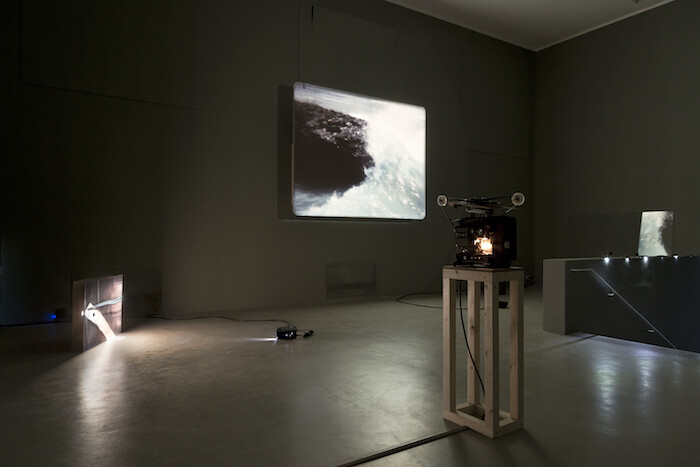Watching João Maria Gusmão and Pedro Paiva’s Cowfish (2001) is harrowing. The poor fool struggles on a plate and then pukes a little water before going still. Any viewer would assume the film’s subject—a cowfish—dies, but in the end its survival remains unclear. Death is withheld by a flicker and a loop back to the start. Gusmão and Paiva prefer the contemplative over the didactic.
Compare to Alexandre Estrela, their contemporary in the Lisbon moving-image scene, who revels in combining video, sculpture, and text. His projects—some of which are included in the show, alongside those of Gusmão and Paiva—possess stroboscopic effects and hypnotic sounds that challenge conventional legibility.
Given their aesthetic and philosophical differences, it would seem the artists’ orbits opposed fruitful alignment, yet, under the auspices of “Lua Cão,” they form a rewarding trine that places their respective works in dialogue. Translated from the Portuguese as “Moon Dog,” the title refers both to an optical phenomenon, in which refracted light creates a halo around the moon, and, via a nod to the American composer Moondog (1916–1999), idiosyncratic third stream jazz—rare essences woven into a phenomenal collaboration.
Described by its creators as an “immersive moving-image experiment,” “Lua Cão” is tailored to the elegant Kunstverein München, which shares curating credit with Natxo Checa, the show’s original instigator. Twenty-one artworks are distributed among five rooms split over two floors of the exhibition space. All except one require a projector. Yet not every part of this panoptic cinema is revealed at once: rather, it unfolds in strategic on-and-off combinations over the course of an evening, guided by a skillful, ever-present projectionist.
Wonderment is the exhibition’s unifying theme. Imagery of the natural world appears often, but it is just as often juxtaposed with the mechanical. All the while, auditory distortions lend the rooms a hallucinatory tone, and herald reconfigurations in the constellation. Viewers like myself, eager for the next reveal, volley across the cavernous space to each new, bright spot. Calmer viewers—like my partner—track a more methodical path. Such is the scope of “Lua Cão” that neither approach is sufficient for catching all its developments.
Though mute, the work of Gusmão and Paiva is far from silent. The chatter of eleven 16mm projectors textures the ambience, calling attention to their own analogue properties and to the traditions of movie making both challenged and championed by the artists. By contrast, many of Estrela’s contributions are conceptually dependent upon sonic elements. Longing for Darkness (2014) has a Fluxus-style score, performed in coordination with footage of a miniature archaeological model. O Cobra Verde [The Green Cobra] (2009) features inhuman moans derived from a recording of a newborn’s cry. But the transducer-inspired Flauta [Flute] (2010) is the most bizarre: a vibrating bamboo rod produces a concussive whir, which emanates from a hollow in its side. The illusion is achieved by synchronizing sound to anaglyphic visual oscillations. It is enhanced by the artist’s distressing decision to align the hollow with a physical hole in the panel onto which the film is projected. Void onto a void, the result is a trembling orifice emanating meontological feedback.
Multidimensional crossover occurs again in Gusmão and Paiva’s Papagaio (Djambi) [Parrot (Djambi)] (2014), a film “[bearing] witness to a West African voodoo ritual”1 somewhere in São Tomé and Príncipe. The participants onscreen ingest alcohol, chew embers, and smoke nose cigarettes in communion with the spirit world. It is one example in the duo’s presentation that would benefit from—some might say requires—elucidation, lest it be accused of a tabloid gaze or glossing over Portugal’s imperial history. However, apprehensions about othering are confronted when the camera is handed to the ecstatic crowd and incorporated into the ceremony, just as the artists themselves were.
Whereas Gusmão and Paiva symbolically gesture toward decolonization ethics, and attempt to thwart the camera’s asymmetrical power dynamics by relinquishing the apparatus itself, Estrela satirizes the lens. I to Infinity (2006) holds at its center the very thing: a video camera’s eye. Its mechanisms are caught in a torus revolution, forcing it into a perpetual zoom. It snags whoever crosses into its sightline, psychically boring into—and colonizing—one’s very being. The piece is chilling, and recalls Harun Farocki’s ironic quip that “gazes don’t destroy anything.”2 It is merely the surveillance ideologies programmed into them that do.
The Kunstverein’s most discrete chamber eludes me for a moment, but while I am suspended between a jewel-toned macaw and a resplendent crashing wave, I detect the warm light coming from within. On entering, I see the man I adore, following the wandering mirror reflections in Gusmão and Paiva’s Heat Ray (2010). At his feet sits Estrela’s appropriately paired Solar Watch (2006), which digitally recreates a diurnal circuit of the desert sun. The radiant disk pulses before dipping wholly below the horizon, bidding farewell to the sand. It throws its beam right through me, and I, too, am spellbound.
Kunstverein München e.V., “Alexandre Estrela + João Maria Gusmão and Pedro Paiva, Lua Cão” (Exhibition notes, 2018).
NICHT löschbares Feuer / Spuren der Inszenierung, Fareed Armaly and Constanze Ruhm, (haus.0 and Künstlerhaus Stuttgart, 2001). Exhibition brochure, as quoted in Constanze Ruhm, “Attachment:,” e-flux journal, no. 59 (November 2014), https://www.e-flux.com/journal/59/61122/attachment/.











